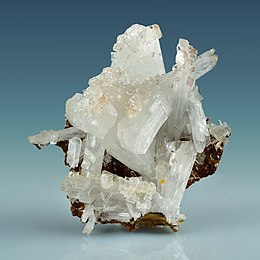Our website is made possible by displaying online advertisements to our visitors.
Please consider supporting us by disabling your ad blocker.
Hemimorphite
This article needs additional citations for verification. (September 2023) |
This article includes a list of general references, but it lacks sufficient corresponding inline citations. (March 2021) |
| Hemimorphite | |
|---|---|
 | |
| General | |
| Category | Sorosilicates |
| Formula (repeating unit) | Zn4Si2O7(OH)2·H2O |
| IMA symbol | Hmp[1] |
| Strunz classification | 9.BD.10 |
| Crystal system | Orthorhombic |
| Crystal class | Pyramidal (mm2) H-M symbol: (mm2) |
| Space group | Imm2 |
| Unit cell | a = 8.367(5), b = 10.73 c = 5.155(3) [Å]; Z = 2 |
| Identification | |
| Color | White, grey |
| Crystal habit | Polar crystals, with different or hemimorphic ends. Also coxcomb masses, mammillary, stalactitic, or massive |
| Twinning | Rare on {001} |
| Cleavage | Perfect on {110}, poor on {101}, {001} rare |
| Fracture | Uneven to conchoidal |
| Tenacity | Brittle |
| Mohs scale hardness | 4.5–5 |
| Luster | Vitreous, adamantine, rarely silky |
| Streak | White |
| Diaphaneity | Transparent to translucent |
| Specific gravity | 3.516–3.525 |
| Optical properties | Biaxial (+) |
| Refractive index | nα = 1.614 nβ = 1.617 nγ = 1.636 |
| Birefringence | δ = 0.022 |
| 2V angle | Measured: 46°, calculated: 44° |
| Solubility | Soluble in acid |
| References | [2][3][4] |
Hemimorphite is the chemical compound Zn4(Si2O7)(OH)2·H2O, a component of mineral calamine. It is a silicate mineral which, together with smithsonite (ZnCO3), has been historically mined from the upper parts of zinc and lead ores. Both compounds were originally believed to be the same mineral and classified as calamine. In the second half of the 18th century, it was discovered that these two different compounds were both present in calamine. They closely resemble one another.
The silicate was the rarer of the two and was named hemimorphite because of the hemimorph development of its crystals. This unusual form, which is typical of only a few minerals, means that the crystals are terminated by dissimilar faces. Hemimorphite most commonly forms crystalline crusts and layers, also massive, granular, rounded and reniform aggregates, concentrically striated, or finely needle-shaped, fibrous or stalactitic, and rarely fan-shaped clusters of crystals.
Some specimens show strong green fluorescence in shortwave ultraviolet light (253.7 nm) and weak light pink fluorescence in longwave UV.
- ^ Warr, L.N. (2021). "IMA–CNMNC approved mineral symbols". Mineralogical Magazine. 85 (3): 291–320. Bibcode:2021MinM...85..291W. doi:10.1180/mgm.2021.43. S2CID 235729616.
- ^ Handbook of Mineralogy
- ^ Webmineral
- ^ Mindat.org
Previous Page Next Page


